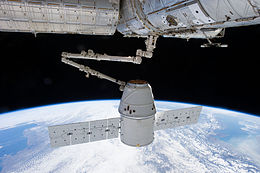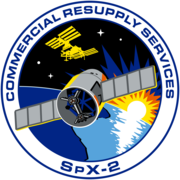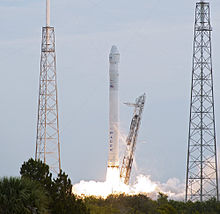 The Dragon spacecraft being berthed to Harmony on 3 March 2013 The Dragon spacecraft being berthed to Harmony on 3 March 2013 | |
| Names | SpX-2 |
|---|---|
| Mission type | ISS resupply |
| Operator | SpaceX |
| COSPAR ID | 2013-010A |
| SATCAT no. | 39115 |
| Mission duration | 25 days, 1 hour, 24 minutes |
| Spacecraft properties | |
| Spacecraft | Dragon 1 C104 |
| Spacecraft type | Dragon 1 |
| Manufacturer | SpaceX |
| Launch mass | 6,000 kg (13,000 lb) |
| Dimensions | Height: 8.1 m (27 ft) Diameter:4 m (13 ft) |
| Start of mission | |
| Launch date | 1 March 2013, 15:10 UTC |
| Rocket | Falcon 9 v1.0 (B0007) |
| Launch site | Cape Canaveral, SLC‑40 |
| End of mission | |
| Disposal | Recovered |
| Landing date | 26 March 2013, 16:34 UTC |
| Landing site | Pacific Ocean |
| Orbital parameters | |
| Reference system | Geocentric orbit |
| Regime | Low Earth orbit |
| Inclination | 51.6° |
| Berthing at ISS | |
| Berthing port | Harmony nadir |
| RMS capture | 3 March 2013, 10:31 UTC |
| Berthing date | 3 March 2013, 13:56 UTC |
| Unberthing date | 26 March 2013, 08:10 UTC |
| RMS release | 26 March 2013, 10:56 UTC |
| Time berthed | 22 days, 18 hours, 14 minutes |
| Cargo | |
| Mass | 898 kg (1,980 lb) |
| Pressurised | 677 kg (1,493 lb) |
| Unpressurised | 221 kg (487 lb) |
 NASA SpX-2 mission patch Commercial Resupply Services← SpaceX CRS-1Orbital-D1 → Cargo Dragon← SpaceX CRS-1SpaceX CRS-3 → | |
SpaceX CRS-2, also known as SpX-2, was the fourth flight for SpaceX's uncrewed Dragon cargo spacecraft, the fifth and final flight for the company's two-stage Falcon 9 v1.0 launch vehicle, and the second SpaceX operational mission contracted to NASA under a Commercial Resupply Services (CRS-1) contract.
The launch occurred on 1 March 2013. A minor technical issue on the Dragon spacecraft involving the RCS thruster pods occurred upon reaching orbit, but it was recoverable. The vehicle was released from the station on 26 March 2013, at 10:56 UTC and splashed down in the Pacific Ocean at 16:34 UTC.
History

The planned shipment of the Falcon 9 first stage from Texas to the Florida launch site was delayed due to the ongoing investigation of the engine failure that occurred on the previous flight. In late November 2012, it was reported that the CRS-2 Falcon 9 had been transported to Cape Canaveral (CCAFS). A static fire test occurred for the CRS-2 Falcon 9 on 25 February 2013.
Firsts
The Dragon unpressurized trunk section, which allows the transport of unpressurized cargo to the ISS, had its first use on this flight. This cargo consisted of two Heat Rejection Subsystem Grapple Fixtures (HRSGFs), which are essentially bars to be attached to the ISS radiators to allow for future movement work.
Payload
When launched the CRS-2 Dragon was filled with about 677 kg (1,493 lb) of cargo, 575 kg (1,268 lb) without packaging. Included is 81 kg (179 lb) of crew supplies, 347 kg (765 lb) of scientific experiments and experiment hardware, 135 kg (298 lb) of hardware for the station and other miscellaneous items, among them a CD copy of the song "Up in the Air" by rock band Thirty Seconds to Mars, was premiered on board the International Space Station (ISS) on 18 March 2013, during a NASA TV broadcast from the station. The two Heat Rejection Subsystem Grapple Fixtures (HRSGFs) had a combined weight of 221 kg (487 lb) and were transported to the ISS inside the unpressurized Dragon trunk as external cargo.
The Dragon returned 1,370 kg (3,020 lb) of cargo, 1,210 kg (2,670 lb) without packaging. Included is 95 kg (209 lb) of crew supplies, 660 kg (1,460 lb) of scientific experiments and experiment hardware, 401 kg (884 lb) of space station hardware, 38 kg (84 lb) of spacesuit equipment and other miscellaneous items.
Dragon thruster pods anomaly
Shortly after second stage separation, at 15:45 UTC on 1 March 2013, the Dragon spacecraft encountered technical problems involving its propulsion system. "When priming its four Draco Thruster Pods, the vehicle detected insufficient pressurization on the oxidizer (Nitrogen Tetroxide) system" of three of the pods which "caused the Flight Computers to place the vehicle in Passive Abort Mode". In this mode, Dragon is not executing any more orbital operations. Its thruster system was disabled and the solar panels were not deployed since the vehicle had not achieved its proper solar panels deployment attitude. "Dragon is programmed not to open its solar panels outside its proper attitude configuration to avoid contact with the second stage. This rule is in place for scenarios in which Dragon is not properly separated from the Falcon 9 booster. As time progressed, teams working at SpaceX Mission Control, MCC-X in Hawthorne, California, started assessments of the issue". During the early minutes and hours of the mission, the mission progress news came in bits, some of it over social media. An update from Elon Musk on Twitter clarified:
Issue with Dragon thruster pods. System inhibiting three of four from initializing. About to command inhibit override.
At 16:12 UTC, Elon Musk announced that a "command inhibit override" would be issued as the Dragon module was "about to pass over Australia ground station". Initially solar panels deployment was held "until at least two thruster pods are active". SpaceX Mission Control decided to proceed with solar deployment due to array temperatures while the spacecraft was not in active attitude control at 16:40 UTC: "Thruster pod 3 tank pressure trending positive. Preparing to deploy solar arrays". At 16:50 UTC, solar arrays had successfully been deployed on the Dragon spacecraft. Three of the four thruster pods on the Dragon spacecraft must be operational for berthing to be allowed with the International Space Station. After making corrections, SpaceX regained control of all four thruster pods and would be able to correct its course to the ISS. According to Elon Musk, "All systems green". NASA officials said that the spacecraft would not rendezvous with the ISS on 2 March 2013 as was originally planned. It would instead rendezvous on 3 March 2013. Dragon was grappled with Canadarm2 by NASA Expedition 34 commander Kevin Ford and NASA flight engineer Tom Marshburn at 10:31 UTC on 3 March 2013, and was berthed to the nadir (Earth-facing) docking port of the Harmony module at 13:56 UTC.
Remainder of mission (3 to 26 March 2013)
On 6 March 2013, the space station's Canadarm2 removed the grapple bars from Dragon's trunk. This event marked the first delivery of unpressurized cargo from a commercial spacecraft to the ISS. The spacecraft's return to Earth was postponed to 26 March 2013 from its originally scheduled date of 25 March 2013 due to inclement weather developing near its targeted splashdown site in the Pacific Ocean. The additional day spent attached to the orbiting laboratory did not affect science samples scheduled to return aboard the spacecraft.
On 26 March 2013, Dragon was unberthed from the Harmony node by the Canadarm2 at 08:10 UTC by commands from ground controllers. Its release from Canadarm2 occurred at 10:56 UTC; the Expedition 35 crew then commanded the spacecraft to slowly depart from the International Space Station. The SpaceX Dragon fired its engines for the last time at 15:42 UTC sending it through the atmosphere of Earth for a splashdown in the Pacific Ocean at 16:34 UTC. A team of SpaceX engineers, technicians and divers recovered the vehicle and its scientific cargo off the coast of Baja California, for the journey back to shore which took about 30 hours.
Gallery
SpaceX CRS-2-
 Dragon before rollout
Dragon before rollout
-
 Launch of CRS-2
Launch of CRS-2
-
 Dragon approaching the ISS
Dragon approaching the ISS
-
 Dragon after reentry and splashdown
Dragon after reentry and splashdown
See also
References
- ^ "Worldwide Launch Schedule". Spaceflight Now. Retrieved 28 May 2012.
- "SpaceX Launch Manifest". SpaceX. Retrieved 31 May 2012.
- ^ "Dragon Splashes Down in Pacific Ocean". NASA. 26 March 2013. Retrieved 26 March 2013.
 This article incorporates text from this source, which is in the public domain.
This article incorporates text from this source, which is in the public domain.
- "DRAGON CRS-2". N2YO.com. Retrieved 29 May 2021.
- ^ "Dragon Docking With Station Set for Sunday". NASA. 2 March 2013. Retrieved 2 March 2013.
 This article incorporates text from this source, which is in the public domain.
This article incorporates text from this source, which is in the public domain.
- "International Space Station Program Overview" (PDF). NASA. November 2012. Retrieved 15 December 2012.
- Hennigan, W. J. (1 March 2013). "SpaceX launches to space station, but experiences problem in orbit". Los Angeles Times. Retrieved 1 March 2013.
- "Dragon CRS-1 Mission Updates". Spaceflight101.com. 28 October 2012. Archived from the original on 12 February 2013. Retrieved 25 November 2012.
- Dean, James (24 November 2012). "SpaceX engine probe delays January flight". Florida Today. Retrieved 25 November 2012.
SpaceX has delivered a Falcon 9 rocket to Cape Canaveral while continuing an engine-problem investigation that will delay the booster's planned launch from mid-January to early March
- "SpaceX conducts successful static fire test". SpaceRef.com. 25 February 2013. Archived from the original on 18 March 2023. Retrieved 1 March 2013.
- Bergin, Chris (19 October 2012). "Dragon enjoying ISS stay, despite minor issues – Falcon 9 investigation begins". NASASpaceFlight.com. Retrieved 21 October 2012.
CRS-2 will debut the use of Dragon's Trunk section, capable of delivering unpressurized cargo, prior to the payload being removed by the ISS' robotic assets after berthing.
- ^ "SpaceX 2 Cargo Manifest" (PDF). NASA. February 2013. Retrieved 22 February 2013.
 This article incorporates text from this source, which is in the public domain.
This article incorporates text from this source, which is in the public domain.
- Makarechi, Kia (28 February 2013). "Thirty Seconds To Mars, 'Up In The Air' To Be Sent Into Space By NASA". The Huffington Post. Retrieved 1 March 2013.
- Shireman, Kirk (April 2013). "International Space Station Program Status" (PDF). NASA. Retrieved 8 September 2013.
- ^ "Dragon CRS-2/SpX-2 Mission Updates". Spaceflight101.com. 26 March 2013. Archived from the original on 6 March 2013. Retrieved 7 April 2013.
- Musk, Elon (1 March 2013). "Issue with Dragon thruster..." Twitter.com. Retrieved 1 March 2013.
- Musk, Elon (1 March 2013). "About to pass over Australia..." Twitter.com. Retrieved 1 March 2013.
- Musk, Elon (1 March 2013). "Holding on solar array deployment..." Twitter.com. Retrieved 1 March 2013.
- Musk, Elon (1 March 2013). "Thruster pod 3 tank pressure..." Twitter.com. Retrieved 1 March 2013.
- Musk, Elon (1 March 2013). "Solar array deployment successful". Twitter.com. Retrieved 1 March 2013.
- Musk, Elon (1 March 2013). "Thruster pods one through four..." Twitter.com. Retrieved 1 March 2013.
- "Space X Dragon Returns To Earth: Complete Coverage". SPACE.com. Archived from the original on 8 April 2013. Retrieved 7 April 2013.
- "SpaceX's Dragon Carrying NASA Cargo Resupplies Space Station". NASA. 3 March 2013.
 This article incorporates text from this source, which is in the public domain.
This article incorporates text from this source, which is in the public domain.
- Bergin, Chris (6 March 2013). "SSRMS removes payload from Dragon trunk to mark new milestone". NASASpaceFlight.com. Retrieved 7 April 2013.
- "Ongoing Science as Crew Counts Down to Dragon Departure, New Trio". NASA. 22 March 2013. Retrieved 7 April 2013.
 This article incorporates text from this source, which is in the public domain.
This article incorporates text from this source, which is in the public domain.
- Bergin, Chris (22 March 2013). "CRS-2 Dragon homecoming delayed due to high seas in the splashdown zone". NASASpaceFlight.com. Retrieved 7 April 2013.
External links
- NASA's SpaceX mission page
- SpaceX CRS-2 Mission Press Kit (February 2013)
- Video of Static Fire test - YouTube (spacexchannel)
- Video of pre-launch press conference - YouTube (ReelNASA)
- Video of launch - YouTube (ReelNASA)
- Video of Dragon arriving at the ISS - YouTube (ReelNASA)
- Video of Dragon leaving the ISS - YouTube (ReelNASA)
- Video of the Dragon capsule arriving at shore and other post-flight activities - YouTube (NASAtelevision)
| SpaceX Dragon 1 and Dragon 2 | |||||||
|---|---|---|---|---|---|---|---|
| Spacecraft |   | ||||||
| Hardware | |||||||
| Missions |
| ||||||
| |||||||
| SpaceX missions and payloads | |||||||||||||||||||||
|---|---|---|---|---|---|---|---|---|---|---|---|---|---|---|---|---|---|---|---|---|---|
| Launch vehicles | |||||||||||||||||||||
| Falcon 1 missions |
| ||||||||||||||||||||
| Falcon 9 missions |
| ||||||||||||||||||||
| Falcon Heavy missions |
| ||||||||||||||||||||
| Starship missions |
| ||||||||||||||||||||
| |||||||||||||||||||||
| Uncrewed spaceflights to the International Space Station | ||
|---|---|---|
| ||
| 2000–2004 |  | |
| 2005–2009 | ||
| 2010–2014 | ||
| 2015–2019 | ||
| 2020–2024 | ||
| Future | ||
| Spacecraft | ||
| ||
| ← 2012Orbital launches in 20132014 → | |
|---|---|
| January | |
| February |
|
| March | |
| April |
|
| May | Zhongxing 11 |
| June |
|
| July |
|
| August |
|
| September |
|
| October |
|
| November |
|
| December |
|
| Launches are separated by dots ( • ), payloads by commas ( , ), multiple names for the same satellite by slashes ( / ). Crewed flights are underlined. Launch failures are marked with the † sign. Payloads deployed from other spacecraft are (enclosed in parentheses). | |